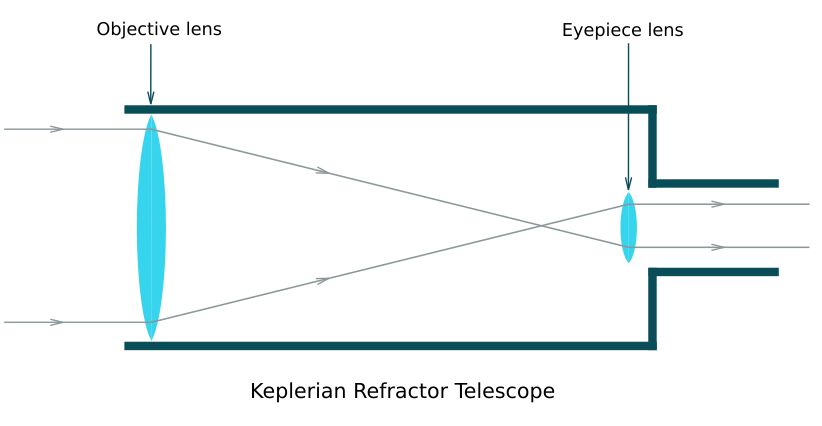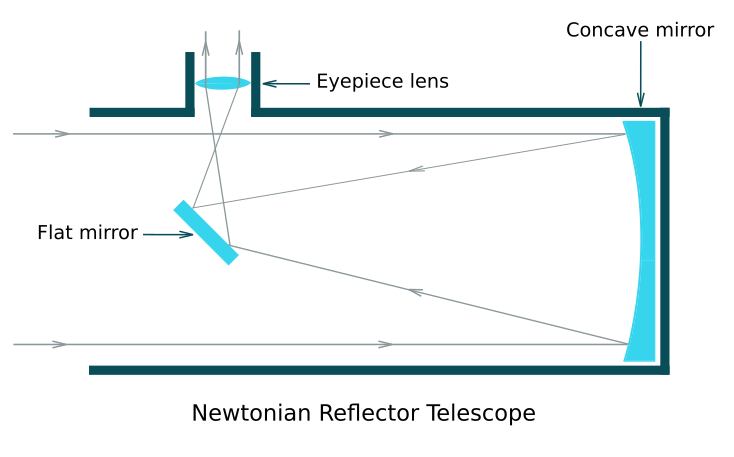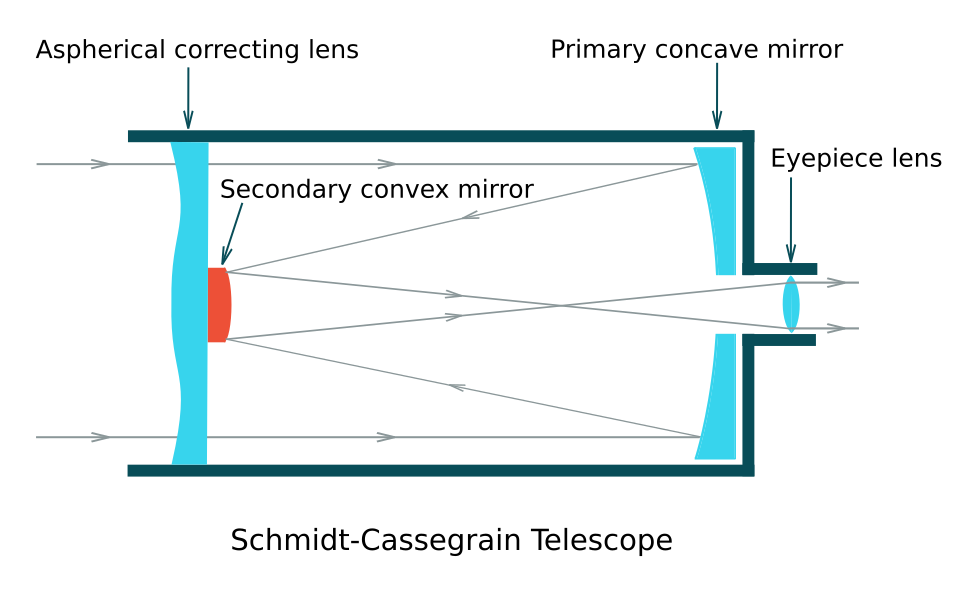Types of Telescopes. Pros, and Cons of Reflectors, Refractors, and Catadioptrics
What does a telescope’s optical system consist of, and how does it work? What types of telescopes for amateur astronomy are known and available on the market? What are their features, advantages and disadvantages? Central part of a telescope is its optical system. The optical system forms an image of an observed object, and the quality of the resulting image depends on the optical system’s type, characteristics and quality. Refractors, reflectors and catadioptrics are three major types of telescope optical systems. Below we describe these major types and show the most popular variants of these designs.
Telescope Optical System Overview and Characteristics
Two major elements of the telescope optical system are an objective and an eyepiece. The objective gathers light from the observed object, refracts or reflects it, and then forms the object’s image. The objective is usually a convex lens or a concave mirror. The eyepiece magnifies the image formed by the objective and directs it into the observer’s eye.
Aperture
Aperture is the diameter of the objective. It is a major telescope characteristic. Large objective gathers more light, and an observer can see more faint objects and more details in space objects.
Focal Length
The focal length of an objective (lens or mirror) is the distance from the lens to the point where the light rays converge. This point is called a focus. Focal length directly influences the magnifying power of a telescope.
Resolving Power
Resolving power is an ability to separate close details in the image. It is a function of aperture alone. The larger the aperture, the greater the resolving power. With a large aperture, an observer can see more crisp images of planets, and galaxies. That is why the aperture is so important telescope characteristic.
Magnification
Magnification or magnifying power of a telescope is calculated as a focal length of an objective divided by focal length of an eyepiece. So magnification can be increased by using an objective with bigger focal length or by using an eyepiece with a smaller focal length. You can use a Barlow lens to get higher magnification also. However, magnification is not a major telescope characteristic as quality of the image is defined by the aperture of the objective.
Refractors
In refractor telescopes a convex lens is used as an objective.
Galilean Optical System
The first refractor was designed by Galileo in 1609. Using his telescope, the great scientist and inventor was the first who observed four moons of Jupiter, spots on the Sun and even mountains on the Moon. The Galilean optical system consists of one convergent objective lens and a divergent eyepiece lens. This design results in a non-inverted image.
Keplerian Optical System
In 1611 Johannes Kepler replaced the divergent eyepiece lens with a convergent one. An advantage of the Keplerian optical system is a much wider field of view and greater eye relief. It results in higher magnifications, but the image is inverted for the viewer. The disadvantage of the Keplerian and Galilean telescopes is strong chromatic aberration.

Achromatic and Apochromatic Objectives
People invented lenses with two and more elements to overcome aberrations and use them as objectives. Such an objective is made of two or more pieces of glass with different dispersion ground, polished and assembled together. The achromatic objective consists of two pieces of glass. The apochromatic lens usually includes three elements and provides even better image correction. An objective with multiple elements requires shorter focal lengths also. Many modern refractor telescopes on the market have achromatic or apochromatic objectives. Apochromatic refractors are often used in professional astrophotography, as they provide high image quality.
Pros and Cons of Refractors
Advantages of Refractors
- Large focal distance allows high magnification to be achieved. This is important for observing the Moon or planets.
- Refractor is maintenance-free. The telescope tube is closed, dust and dirt does not get inside the tube.
- Refractors usually do not need to be adjusted. Telescopes from a factory are usually perfectly adjusted and do not require any additional adjustment.
- Relatively small dimensions when disassembled. It is easy to transport in a car or in a special bag.
- Achromatic and especially apochromatic objectives are free from chromatic aberration and give a very high quality of picture, which is important in astrophotography.
Disadvantages of Refractors
- Objective lens results in chromatic aberration. Light, when passing through the objective lens, is split into all colors of the rainbow. Unfortunately, all of these colors are focused at different points. Chromatic aberration leads to purple halo around bright objects in an image. To solve this problem, two-lens objectives (achromats), and three-lens objectives (apochromats) are used. Apochromats remove chromatic aberration almost completely. However, apochromats are harder to produce that is why the price of such triplets is much higher.
- As the aperture increases, the price of the telescope rises dramatically. Moreover, the price of a refractor is growing disproportionately. If, for example, we increase the aperture by 2 times, then the price can increase by 10 times.
- Long tube length. The length of the tube is approximately equal to the focal length. Usually refractors are long-focus devices. The tube therefore will be long too. For example, if the focal length is 900 mm, then the length of the tube is about 1 meter. This is definitely worth considering if you are going to observe from a balcony.
- The last drawback is relatively long thermal stabilization. The point is that the telescope tube is closed. It takes time for the air temperature inside the tube to equal the ambient temperature. It is hard to determine thermal stabilization time precisely. It depends on the size of your telescope and on the temperature difference. On average, you should wait for about one hour.
Reflector Optical Systems
In 1663 Scottish astronomer James Gregory was the first to propose a telescope system which uses mirrors. The main concave parabolic mirror in the Gregorian telescope reflects light onto a smaller concave mirror. Then the light is reflected into the central hole of the first mirror.
Newtonians
Several years later, in 1668 Isaac Newton invented a similar optical system with mirrors. In Newton’s reflector telescope, the light is collected by a parabolic or spherical mirror and is directed onto a flat diagonal mirror, which directs a beam of light outside the tube to the eyepiece.
Telescope’s ability to see distant objects in detail depends on its objective diameter. It is much easier to produce a large mirror than to produce the same diameter lens. That is why modern scientific telescopes of large magnification are reflectors.

Ritchey-Chretiens
There are other mirror optical system designs. In the early 1910s George Willis Ritchey and Henri Chrétien came up with a reflector consisting of two hyperbolic mirrors. Unlike reflectors with spherical mirrors, this optical system is free from spherical aberration and thus it gives very high image quality. Ritchey–Chrétien design is used in many modern professional telescopes.
Dobsonians
Dobsonian is actually a Newtonian reflector telescope on a special alt-azimuth mount invented and popularized by John Dobson. Dobsonian’s mount is simple, easy to produce and thus cheaper than other designs with the same aperture. The mount was specially designed to carry large aperture telescopes. So with dobsonian you can observe faint space objects.
Pros and Cons of Reflectors
Advantages of Reflectors
- The advantages include, first, relatively low price for a large aperture. A large mirror is much easier to manufacture than а large lens. Consequently, a mirror’s price is much less.
- The second is the complete absence of chromatic aberration. Chromatic aberration is caused by a lens. Since the reflector objective is a mirror, it has no chromatic aberration.
- Reflectors have high light-gathering power, which is probably the most important telescope feature. Mirror system made large diameter telescopes affordable for amateur astronomers.
- An eyepiece in reflector telescope is located at the top of the tube. Therefore reflectors do not need tall mounts. It is convenient to observe objects nearly above the head using Newtonian reflector.
- The reflector tube is shorter than that of refractors, since most of its length the light flux passes twice. The mount of the reflector is also shorter. Reflector’s weight is concentrated low down, so we don’t need a strong tube. This all makes it possible to house a much larger instrument in a given space.
Disadvantages of Reflectors
- If a spherical mirror is used in a reflector, then spherical aberration arises. The image can not be focused in one plane: if the central part of the image is focused, it will be slightly blurred at the edges. This drawback is absent, when the mirror is parabolic or hyperbolic.
- Reflector usually has an open tube, and the mirror’s surface is exposed to dust and humidity. Sooner or later the main mirror will be covered with a layer of dust or dirt. That is why the reflecting telescope should be periodically dismounted, and its optical parts should be cleaned.
- Reflectors require periodical adjustment which is called collimation. The aim of the collimation is to adjust the optical system so that all the light collected by the objective mirror falls on the diagonal mirror and finally into the eyepiece. This adjustment should ideally be done before each observation. This procedure is easier to perform with a special device called a collimator.
Catadioptrics
One more type of scopes is catadioptric or also called compound telescopes. Сatadioptric telescopes include both mirrors and lenses as parts of their optical system. In catadioptric optical systems the lens has a size comparable to mirror size. The lens is often used to correct the spherical aberration created by the mirror.
The first catadioptric telescope consisted of a spherical mirror and silver-backed negative lens. It was patented in 1814 by W. F. Hamilton. In 1931 Bernhard Schmidt added a special lens at the center of curvature of the mirror. This lens is called a Schmitt corrector. It has a fourth-order surface to remove spherical aberration.
Schmidt–Cassegrain
Schmidt’s optical system has a spherical focal surface. To flatten the focal surface James Gilbert Baker proposed to add a second convex mirror. This optical system with Schmidt corrector and secondary mirror is now called Schmidt–Cassegrain. It is one of the most popular optical designs in amateur astronomy.
In Schmidt–Cassegrain optical system light from the observed object enters the tube through the correcting lens. Then the light is reflected from the primary mirror to fall onto the secondary mirror. After reflection from the secondary mirror the rays are directed into the hole of the first mirror and come through the eyepiece.

Maksutov–Cassegrain
Another popular variant of the catadioptric system is the Maksutov telescope. In this design the Schmidt corrector plate is replaced by a spherical meniscus lens. Most commonly seen variant of the Maksutov telescope is the Maksutov–Cassegrain system which has a silvered “spot” on the meniscus corrector.
Pros and Cons of Catadioptrics
Advantages of Catadioptrics
- Catadioptric telescopes are the most compact ones in comparison with refractors and reflectors. Because the rays pass along the tube three times. This type is the best variant if you are going to make astronomical observations from a balcony or in similar tight conditions.
- The next advantage is the absence of spherical aberration. It is completely removed by the corrector lens. Although it results in other distortions such as the wavefront aberration. But this is not as critical as the presence of spherical aberration.
- The third advantage is a close tube. Maintenance of such a telescope is easy. Dust or dirt does not get inside the tube. Therefore, there is no need to disassemble and clean the telescope.
- Catadioptric telescopes are easier to transport due to their compact size.
Disadvantages of Catadioptrics
- Close tube was mentioned as an advantage of catadioptric. However it is a drawback also. Catadioptrics have long thermal stabilization. This optical system has a mirror and lens and both of these elements need to take the ambient temperature in a closed tube. Thermal stabilization of catadioptrics takes up to 2 hours depending on the scope’s size.
- Catadioptric telescopes of the same aperture usually are more expensive than reflectors due to the complexity of their optical system.
- Long focal length in catadioptrics leads to a narrow field of view. With a narrow field of view it is inconvenient to observe extended objects like galaxies and nebulas.
- In comparison with newtonians, catadioptrics are heavier due to the presence of large correcting lens.
